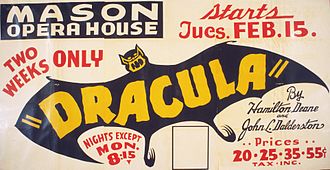- Dracula (1924 play)
-
Dracula is a 1924 stage play adapted by Hamilton Deane from the novel of the same name by Bram Stoker, and substantially revised by John L. Balderston in 1927. It was the first adaptation of the novel authorised by Stoker's widow, and has influenced many subsequent adaptations.
The original production starred Raymond Huntley as Dracula; Deane had originally intended to play the title role himself, but in the event opted for the role of Van Helsing. This production toured England for three years before settling in London.
In 1927 the play was brought to Broadway by Horace Liveright, who hired John L. Balderston to revise the script for American audiences. The American production starred Bela Lugosi in his first major English-speaking role, with Edward Van Sloan as Van Helsing; both actors reprised their roles in the 1931 film version, which drew on the Deane-Balderston play.
In addition to radically compressing the plot, the play reduced the number of significant characters, combining Lucy Westenra and Mina Murray into a single character, making John Seward this Lucy's father, and disposing of Quincey Morris and Arthur Holmwood.
The play was revived in 1977, in a production featuring set and costume designs by Edward Gorey and starring Frank Langella as Dracula. The production won Tony Awards for Best Revival and Best Costume Design, and was nominated for Best Scenic Design and Best Leading Actor in a Play (Langella). Langella, like Lugosi, went on to reprise the role in the 1979 film version. Subsequent actors in the title role for the Broadway revival included David Dukes, Raul Julia and Jean LeClerc, while the London production starred Terence Stamp and American touring companies starred Martin Landau and Jeremy Brett.
Contents
Original cast
1924 London cast
- Count Dracula: Raymond Huntley
- Abraham van Helsing: Hamilton Deane
- Doctor Seward: Stuart Lomath
- Jonathan Harker: Bernard Guest
- Quincy P. Morris: Frieda Hearn
- Lord Godalming: Peter Jackson
- R. M. Renfield: Bernard Jukes
- The Warder: Jack Howarth
- The Parlourmaid: Hilda Macleod
- The Housemaid: Betty Murgatroyd
- Mina Harker: Dora Mary Patrick
1927 New York cast
- Count Dracula: Bela Lugosi
- Abraham Van Helsing: Edward Van Sloan
- Dr. Seward: Herbert Bunston
- Lucy Harker: Dorothy Peterson
- Jonathan Harker: Terence Neill
- R.M. Renfield: Bernard Jukes
- Butterworth: Alfred Frith
- Miss Wells, a maid: Nedda Harrigan
Deviations from the novel
Original version
- When Lucy is mentioned her last name is Westera not Westenra.
- The play begins after the death of Mina (who is mentioned but never seen).
- In Deane's original production, Quincey Morris was a woman, perhaps due to a shortage of male actors.[3]
Revised version
- The characters of Arthur Holmwood and Quincey Morris are omitted.
- Dr Seward is now Lucy's father rather than her suitor. He runs a mental institute in the English countryside, rather than adjoining Carfax Abbey, London.
- Harker's first name is John not Jonathan, and he does not go to Transylvania, Renfield does. Count Dracula is already living in England by the time the play starts.
- A new character is introduced, Lucy's maid, who survives.
- Harker and Lucy do not marry as he and Mina did in the novel.
- Dracula sleeps under Dr Seward's house. It is here that he is staked by Harker, rather than stabbed by Morris, after Van Helsing tricks Renfield into revealing the location of Dracula's coffins.
- Renfield survives.
References
- ^ Summers, Augustus Montague. "The Vampire in Literature" (Google Books). The Vampire, his Kith and Kin. p. 296. http://books.google.com.au/books?id=fpaCCyGuMqwC&pg=PA296. Retrieved 2009-02-03.
- ^ Rhodes, Gary Don. "Stage Appearances" (Google Books). Lugosi: his life in films, on stage, and in the hearts of horror lovers. p. 169. http://books.google.com.au/books?id=Aueo3mOrIKIC&pg=PA169. Retrieved 2009-02-18.
- ^ Stuart, Roxana. "Dracula: Stage Adaptations, 1897-1985" (Google Books). Stage Blood: vampires of the 19th-century stage. p. 195. http://books.google.com.au/books?id=flzKFymvfj0C&pg=PA195. Retrieved 2009-02-18.
External links and references
- Dracula on the Boards at The Dracula Guide
- Dracula at National Players
- Dracula at the Internet Broadway Database
Categories:- 1924 plays
- 1927 plays
- Works inspired by Dracula
- Plays based on novels
Wikimedia Foundation. 2010.

